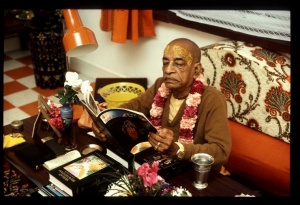CC Madhya 6.73

A.C. Bhaktivedanta Swami Prabhupada
TEXT 73
gopīnātha kahe,—iṅhāra nāhi bāhyāpekṣā
ataeva baḍa sampradāyera nāhika apekṣā
SYNONYMS
gopīnātha kahe—Gopīnātha Ācārya replied; iṅhāra—of the Lord; nāhi—there is not; bāhya-apekṣā—dependence on any external formality; ataeva—therefore; baḍa—big; sampradāyera—of a community; nāhika—there is not; apekṣā—necessity.
TRANSLATION
Gopīnātha Ācārya replied, “Śrī Kṛṣṇa Caitanya Mahāprabhu does not rely on any external formality. There is no need for Him to accept the sannyāsa order from a superior sampradāya.”
PURPORT
Śrī Caitanya Mahāprabhu accepted sannyāsa from the Bhāratī sampradāya (community), which belongs to the disciplic succession of Śaṅkarācārya. Śaṅkarācārya introduced names for his sannyāsa disciples, and these are ten in number. Out of these, the surnames Tīrtha, Āśrama and Sarasvatī are considered topmost. In the monastery at Śṛṅgerī, the surname Sarasvatī is considered first class, Bhāratī second class and Purī third class. A sannyāsī who has very nicely understood the slogan tat tvam asi and who takes his bath at the confluence of the rivers Ganges, Yamunā and Sarasvatī is called a Tīrtha. A person who is very eager to accept sannyāsa, who is detached from worldly activities, who has no desire for any kind of material facilities, and who is thus saved from repeated birth and death is known as Āśrama. When a sannyāsī lives in a beautiful, solitary place in the forest and is freed from all material desires, he is called Vana. A sannyāsī who always lives in the forest and renounces all connection with the world in order to be elevated to the heavenly planets, where he can live in the Nandana-kānana, is called Araṇya. One who prefers living in the mountains engaging in the study of the Bhagavad-gītā and whose intelligence is fixed is called Giri. One who prefers living in great mountains, even among ferocious animals, to attain the summit of philosophical speculation (understanding that the essence of this material world is useless) is called Parvata. A sannyāsī who has dipped into the ocean of the Absolute Truth and collected some valuable stones of knowledge from that ocean, who never falls from the regulative principles of a sannyāsī, is called Sāgara. One who has learned the classical art of music, who engages in its culture, and who has become expert and completely aloof from material attachment is called Sarasvatī. Sarasvatī is the goddess of music and learning, and in one hand she holds a musical instrument called a vīṇā. A sannyāsī who is always engaged in music for spiritual elevation is called Sarasvatī. One who has become completely educated and is freed from all kinds of ignorance and who is never unhappy, even in a distressed condition, is called Bhāratī. One who has become very expert in absolute knowledge, who is situated in the Absolute Truth, and who always discusses the Absolute Truth is called Purī.
All these sannyāsīs are assisted by brahmacārīs, who are described as follows: One who knows his real identity and is fixed in his particular occupational duty, who is always happy in spiritual understanding, is called Svarūpa-brahmacārī. One who completely knows the Brahman effulgence and is always engaged in the practice of yoga is called Prakāśa-brahmacārī. One who has acquired absolute knowledge and who always meditates on the Absolute Truth, knowledge, the unlimited and the Brahman effulgence, thus keeping himself in transcendental bliss, is called Ānanda-brahmacārī. One who is able to distinguish between matter and spirit, who is never disturbed by material transformations, and who meditates on the unlimited, inexhaustible, auspicious Brahman effulgence is a first-class, learned brahmacārī and is named Caitanya.
When Sārvabhauma Bhaṭṭācārya was talking with Gopīnātha Ācārya about Śrī Caitanya Mahāprabhu’s sannyāsa community, he appreciated the first name, “Śrī Kṛṣṇa,” but did not like the surname, “Caitanya,” which is the name for a brahmacārī belonging to the Bhāratī community. He therefore suggested that the Lord be elevated to the Sarasvatī community. However, Gopīnātha Ācārya pointed out that the Lord does not depend on any external formality. Gopīnātha Ācārya was firmly convinced that Śrī Caitanya Mahāprabhu was Kṛṣṇa Himself and therefore independent of any external ritual or formality. If one wants to engage in pure devotional service, he does not require titular superiority as a Bhāratī or a Sarasvatī.